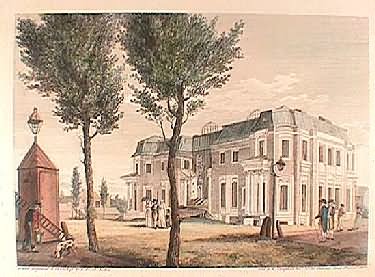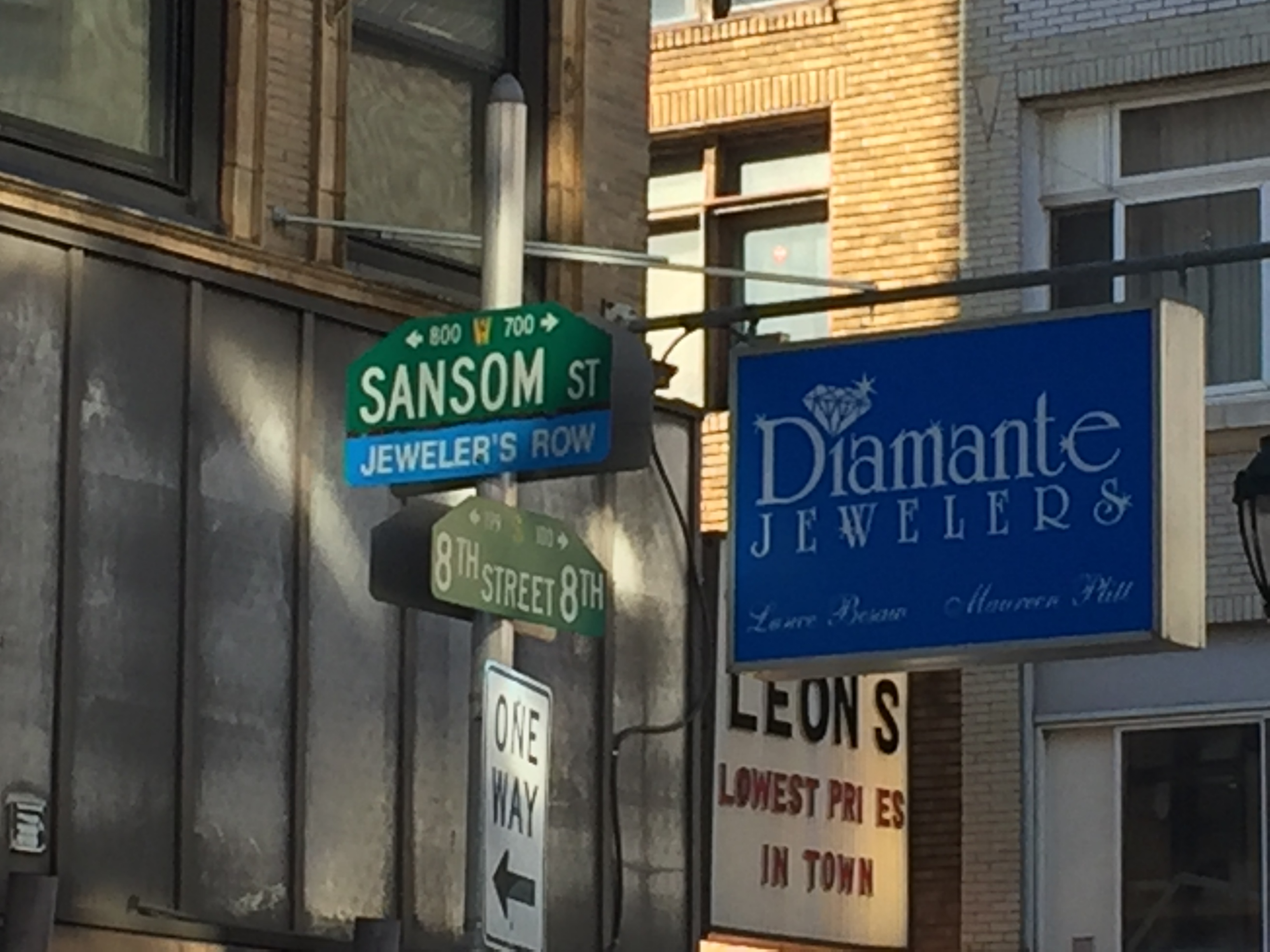Carstairs Row on:
[Wikipedia]
[Google]
[Amazon]
Jewelers' Row, located in the Center City section of
 Jeweler’s Row (Carstairs Row) was designed by builder and architect Thomas Carstairs circa 1799 through 1820, for developer William Sansom, as part of the first speculative
Jeweler’s Row (Carstairs Row) was designed by builder and architect Thomas Carstairs circa 1799 through 1820, for developer William Sansom, as part of the first speculative
Sansom bought (at sheriff's sale) the property and unfinished house of Robert Morris, on Walnut St. between 7th and 8th Sts. He bisected the land with a new east-west eponymous street. Carstairs purchased the south side of Sansom St. and erected 22 look-alike dwellings. Prior to this time houses had been built not in rows, but individually. It can be contrasted with Elfreth's Alley where all the house are of varying heights and widths, with different street lines, doorways and brickwork. The grid pattern laid down by
 Alterations in the late 19th and early 20th centuries changed most of the row – only 700, 730 and 732 Sansom retained their original experience. 710 Sansom, built in 1870, is a three-story commercial building with stone lintels. Its Victorian style is typical of the buildings that became the center for jewelry and diamond merchants who developed Jewelers’ Row in the mid-19th century (1860–1879).
722 Sansom was originally built in the 1860s and was redesigned in the early 1900s when steel became available. 724 Sansom, built in 1875, has a cast iron first floor.
After the homes were sold for commercial interests, several engravers of plates for books moved in. At 732, the engraver for
Alterations in the late 19th and early 20th centuries changed most of the row – only 700, 730 and 732 Sansom retained their original experience. 710 Sansom, built in 1870, is a three-story commercial building with stone lintels. Its Victorian style is typical of the buildings that became the center for jewelry and diamond merchants who developed Jewelers’ Row in the mid-19th century (1860–1879).
722 Sansom was originally built in the 1860s and was redesigned in the early 1900s when steel became available. 724 Sansom, built in 1875, has a cast iron first floor.
After the homes were sold for commercial interests, several engravers of plates for books moved in. At 732, the engraver for
Center City District and Central Philadelphia Development CorporationJewelers Row Philadelphia Website
{{Philadelphia Neighborhoods in Philadelphia Jewellery districts Economy of Philadelphia Center City, Philadelphia Jewelry industry in the United States
Philadelphia, Pennsylvania
Philadelphia, often called Philly, is the List of municipalities in Pennsylvania#Municipalities, largest city in the Commonwealth (U.S. state), Commonwealth of Pennsylvania, the List of United States cities by population, sixth-largest city i ...
, is composed of more than 300 retailers, wholesaler
Wholesaling or distributing is the sale of goods or merchandise to retailers; to industrial, commercial, institutional or other professional business users; or to other wholesalers (wholesale businesses) and related subordinated services. In ...
s, and craftsmen located on Sansom Street between Seventh and Eighth Streets, and on Eighth Street between Chestnut and Walnut Streets.
It is the oldest diamond district in America, and second in size only to the one in New York City. Many of the area's retail
Retail is the sale of goods and services to consumers, in contrast to wholesaling, which is sale to business or institutional customers. A retailer purchases goods in large quantities from manufacturers, directly or through a wholesaler, and th ...
, jewelrymaking and appraisal Appraisal may refer to:
Decision-making
* Appraisal (decision analysis), a decision method
* Archival appraisal, process for determining which records need to be kept, and for how long
* Project appraisal, comparing options to deliver an objectiv ...
businesses have been owned by the same families for five generation
A generation refers to all of the people born and living at about the same time, regarded collectively. It can also be described as, "the average period, generally considered to be about 20–30 years, during which children are born and gro ...
s.
History
 Jeweler’s Row (Carstairs Row) was designed by builder and architect Thomas Carstairs circa 1799 through 1820, for developer William Sansom, as part of the first speculative
Jeweler’s Row (Carstairs Row) was designed by builder and architect Thomas Carstairs circa 1799 through 1820, for developer William Sansom, as part of the first speculative housing development
A housing estate (or sometimes housing complex or housing development) is a group of homes and other buildings built together as a single development. The exact form may vary from country to country.
Popular throughout the United States a ...
s in the United States
The United States of America (U.S.A. or USA), commonly known as the United States (U.S. or US) or America, is a country primarily located in North America. It consists of 50 U.S. state, states, a Washington, D.C., federal district, five ma ...
, and introduction of the Row house in the United States. Carstairs Row was built on the southern part of the site occupied by "Morris' Folly" – Robert Morris’ unfinished mansion designed by Pierre Charles L'Enfant
Pierre "Peter" Charles L'Enfant (; August 2, 1754June 14, 1825) was a French-American military engineer who designed the basic plan for Washington, D.C. (capital city of the United States) known today as the L'Enfant Plan (1791).
Early life ...
.National Park Service - Signers of the Declaration (Robert Morris)Sansom bought (at sheriff's sale) the property and unfinished house of Robert Morris, on Walnut St. between 7th and 8th Sts. He bisected the land with a new east-west eponymous street. Carstairs purchased the south side of Sansom St. and erected 22 look-alike dwellings. Prior to this time houses had been built not in rows, but individually. It can be contrasted with Elfreth's Alley where all the house are of varying heights and widths, with different street lines, doorways and brickwork. The grid pattern laid down by
William Penn
William Penn ( – ) was an English writer and religious thinker belonging to the Religious Society of Friends (Quakers), and founder of the Province of Pennsylvania, a North American colony of England. He was an early advocate of democracy an ...
and continued by subsequent planners and surveyors heavily influenced the row house form of architecture. The block of row houses is an important example of Philadelphia’s architectural and developmental history.
Sansom erected the buildings on what was then the outskirts of Philadelphia. To attract tenants he paved Sansom Street at his own expense. He then hired Benjamin Latrobe
Benjamin Henry Boneval Latrobe (May 1, 1764 – September 3, 1820) was an Anglo-American neoclassical architect who emigrated to the United States. He was one of the first formally trained, professional architects in the new United States, draw ...
to design another row on the 700 block of Walnut Street. A prominent feature of the street is the repetitive flat expanse of the buildings, which made it ideal for commercial conversion.
In 2016, real estate company Toll Brothers obtained a zoning and demolition permit to construct a twenty-nine story tower of condominiums on the 700 block of Sansom Street. Specifically, five buildings from 702 to 710 Sansom would be demolished. The Preservation Alliance for Greater Philadelphia nominated two of the buildings for listing in the Philadelphia Register of Historic Places, which included the former Publishing House of Henry C. Lea, Co. at 706 Sansom Street and a former Electrotype Foundry at 704 Sansom Street. This decision has been met with fierce local opposition, with signs denouncing the project appearing in the windows of several buildings on Sansom Street, as well as criticism from ''Philadelphia Inquirer
''The Philadelphia Inquirer'' is a daily newspaper headquartered in Philadelphia, Pennsylvania. The newspaper's circulation is the largest in both the U.S. state of Pennsylvania and the Delaware Valley metropolitan region of Southeastern Penns ...
'' architecture columnist Inga Saffron.
Changes throughout the years
 Alterations in the late 19th and early 20th centuries changed most of the row – only 700, 730 and 732 Sansom retained their original experience. 710 Sansom, built in 1870, is a three-story commercial building with stone lintels. Its Victorian style is typical of the buildings that became the center for jewelry and diamond merchants who developed Jewelers’ Row in the mid-19th century (1860–1879).
722 Sansom was originally built in the 1860s and was redesigned in the early 1900s when steel became available. 724 Sansom, built in 1875, has a cast iron first floor.
After the homes were sold for commercial interests, several engravers of plates for books moved in. At 732, the engraver for
Alterations in the late 19th and early 20th centuries changed most of the row – only 700, 730 and 732 Sansom retained their original experience. 710 Sansom, built in 1870, is a three-story commercial building with stone lintels. Its Victorian style is typical of the buildings that became the center for jewelry and diamond merchants who developed Jewelers’ Row in the mid-19th century (1860–1879).
722 Sansom was originally built in the 1860s and was redesigned in the early 1900s when steel became available. 724 Sansom, built in 1875, has a cast iron first floor.
After the homes were sold for commercial interests, several engravers of plates for books moved in. At 732, the engraver for Edgar Allan Poe
Edgar Allan Poe (; Edgar Poe; January 19, 1809 – October 7, 1849) was an American writer, poet, editor, and literary critic. Poe is best known for his poetry and short stories, particularly his tales of mystery and the macabre. He is wide ...
lived and worked. His customer, Poe, ate dinner in the house on several occasions.
See also
*Independence National Historical Park
Independence National Historical Park is a federally protected historic district in Philadelphia, Pennsylvania that preserves several sites associated with the American Revolution and the nation's founding history. Administered by the Nation ...
* Goldsmith
A goldsmith is a metalworker who specializes in working with gold and other precious metals. Nowadays they mainly specialize in jewelry-making but historically, goldsmiths have also made silverware, platters, goblets, decorative and servicea ...
* Silversmith
A silversmith is a metalworker who crafts objects from silver. The terms ''silversmith'' and ''goldsmith'' are not exactly synonyms as the techniques, training, history, and guilds are or were largely the same but the end product may vary gre ...
* Bench Jeweler
A bench jeweler is an artisan who uses a combination of skills to make and repair jewelry. Some of the more common skills that a bench jeweler might employ include antique restoration, silversmith, Goldsmith, stone setting, engraving, fabricat ...
References
NotesExternal links
Center City District and Central Philadelphia Development Corporation
{{Philadelphia Neighborhoods in Philadelphia Jewellery districts Economy of Philadelphia Center City, Philadelphia Jewelry industry in the United States